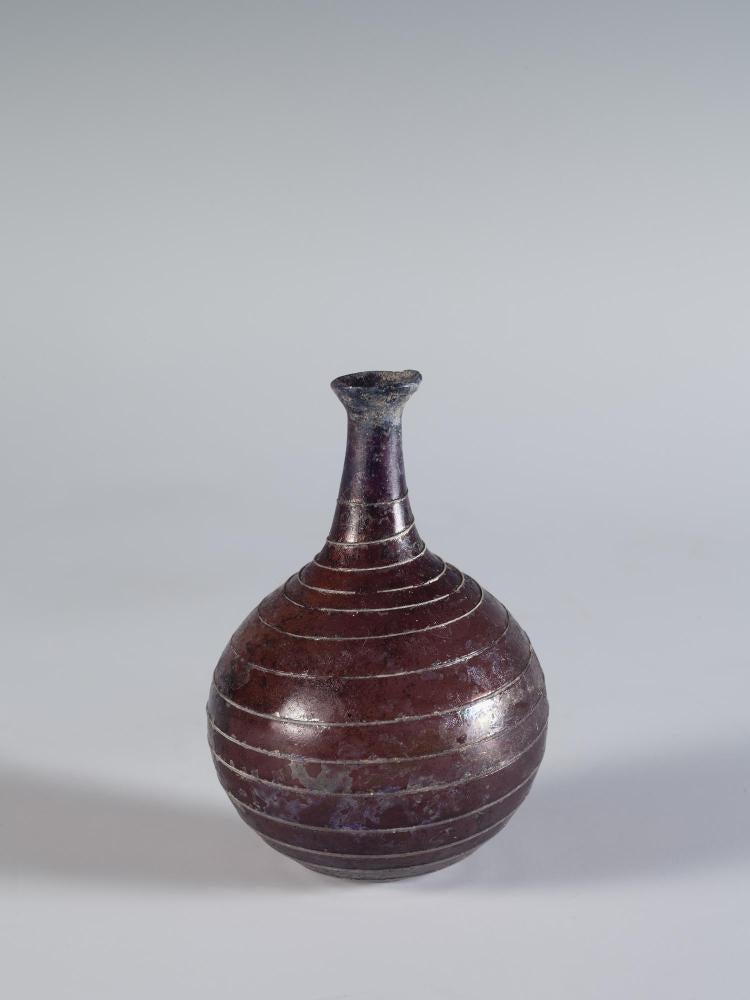2008.18.2.7, Roman Bottle with Funnel Mouth
Catalogue Entry 

From the Catalogue of Ancient Glass in the University of Colorado Museum
Gift of H. Medill Sarkisian and Justine Sarkisian Rodriguez (1979)
Transferred to CU Art Museum (2008)
Height: 7.6 cm
Diameter (max.): 5.1 cm
Roman, late 2nd century C.E.
Classification: Isings Form 92; Harden Fabric 6
Description: Uneven lip with short funnel-shaped mouth. Narrow cylindrical neck that tapers out toward bottom. Smooth transition from neck to bulbous body with rounded base. Purple with white trail would spirally from base to middle of neck. Some iridescence and flaking. Blown, thread applied afterwards.
Comment: The purple color comes from the exposure of manganese compounds in the glass to sunlight. Similar examples are Eisen 1927, pl. 90; Dusenbery 1967, no. 17; Hayes 1975, no. 112; Fitzwilliam Museum 1978, no. 93c; Constable-Maxwell Collection 1979, lot 55; Whitehouse 2001, no. 700; Schlick-Nolte 2002, no. V-51; and Weinberg and Stern 2009, G 128.
Discussion
The spiral design that runs from the bottom to the top of this bottle was made by "threading." A thin thread of contrasting glass (in this case, white glass) is allowed to drip from a rod onto the finished glass vase while it is turned. The thread is initially raised off the surface of the vessel until the glassmaker rolls the bottle on a slab, flattening the thread until it lies flush with the surface or heating it until the thread melts flat (1). Threading was a popular style of decoration in ancient Roman glass (2).
The purple color of this glass was created by adding manganese to the ingredients of the glass. Manganese provided a few possible outcomes for Roman glass manufacturers: a small amount could remove any tint from glass and result in a colorless fabric, a larger amount made glass turn yellow, and an even larger amount of manganese could tint the glass a deep purple, like this vase. The sands in Egypt contained a natural level of manganese, which might explain why the Egyptians became so skilled in manipulating tinted glass by adding manganese to the mixture. Roman glassmakers could have learned these skills through trade (3).
Footnotes
- E. Marianne Stern, Roman, Byzantine, and Early Medieval Glass (New York: Hatje Cantz Publishers, 2001): 38, 57.
- Stern 2001: 130-132.
- Donald B. Harden, Roman Glass from Karanis (Ann Arbor: University of Michigan Press, 1936): 6-8.
References
- Catalogue of the Constable-Maxwell Collection of Ancient Glass. London: Maggs Brothers, 1979.
- Dusenbery, E. B. “Ancient Glass from the Cemeteries of Samothrace,” Journal of Glass Studies 9 (1967): 34-49.
- Eisen, G. A. Glass: Its Origin, History, Chronology, Technic and Classification to the Sixteenth Century, v. 1. New York: W. E. Rudge, 1927.
- Glass at the Fitzwilliam Museum. Cambridge: Cambridge University Press, 1978.
- Hayes, J. W. Roman and Pre-Roman Glass in the Royal Ontario Museum. Toronto: 1975.
- Schlick-Nolte, B. “Catalogue of Ancient Glass,” in Reflections on Ancient Glass from the Borowski Collection, ed. R. S. Bianchi, B. Schlick-Nolte, G. M. Bernheimer, and Dan Barag. Mainz: P. von Zabern, 2002: 47-109.
- Weinberg, G. D. and E. M. Stern. Vessel Glass. Athenian Agora Vol. 34. Princeton: The American School of Classical Studies at Athens, 2009.
- Whitehouse, D. Roman Glass in the Corning Museum of Glass, v. 2. Corning, NY: Corning Museum of Glass, 2001.

